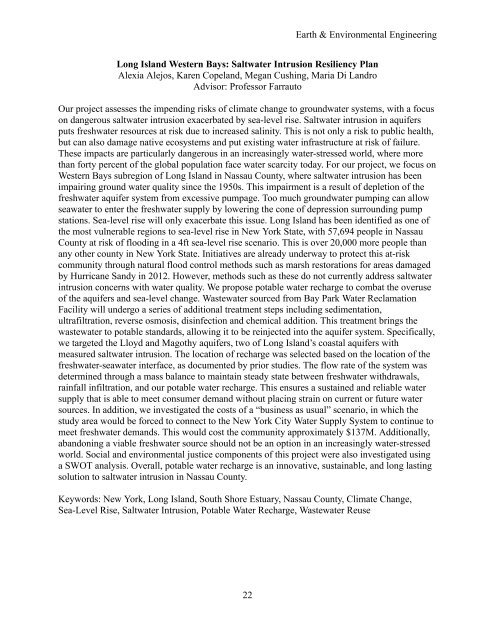Create successful ePaper yourself
Turn your PDF publications into a flip-book with our unique Google optimized e-Paper software.
Earth & Environmental Engineering<br />
Long Island Western Bays: Saltwater Intrusion Resiliency Plan<br />
Alexia Alejos, Karen Copeland, Megan Cushing, Maria Di Landro<br />
Advisor: Professor Farrauto<br />
Our project assesses the impending risks of climate change to groundwater systems, with a focus<br />
on dangerous saltwater intrusion exacerbated by sea-level rise. Saltwater intrusion in aquifers<br />
puts freshwater resources at risk due to increased salinity. This is not only a risk to public health,<br />
but can also damage native ecosystems and put existing water infrastructure at risk of failure.<br />
These impacts are particularly dangerous in an increasingly water-stressed world, where more<br />
than forty percent of the global population face water scarcity today. For our project, we focus on<br />
Western Bays subregion of Long Island in Nassau County, where saltwater intrusion has been<br />
impairing ground water quality since the 1950s. This impairment is a result of depletion of the<br />
freshwater aquifer system from excessive pumpage. Too much groundwater pumping can allow<br />
seawater to enter the freshwater supply by lowering the cone of depression surrounding pump<br />
stations. Sea-level rise will only exacerbate this issue. Long Island has been identified as one of<br />
the most vulnerable regions to sea-level rise in New York State, with 57,694 people in Nassau<br />
County at risk of flooding in a 4ft sea-level rise scenario. This is over 20,000 more people than<br />
any other county in New York State. Initiatives are already underway to protect this at-risk<br />
community through natural flood control methods such as marsh restorations for areas damaged<br />
by Hurricane Sandy in 2012. However, methods such as these do not currently address saltwater<br />
intrusion concerns with water quality. We propose potable water recharge to combat the overuse<br />
of the aquifers and sea-level change. Wastewater sourced from Bay Park Water Reclamation<br />
Facility will undergo a series of additional treatment steps including sedimentation,<br />
ultrafiltration, reverse osmosis, disinfection and chemical addition. This treatment brings the<br />
wastewater to potable standards, allowing it to be reinjected into the aquifer system. Specifically,<br />
we targeted the Lloyd and Magothy aquifers, two of Long Island’s coastal aquifers with<br />
measured saltwater intrusion. The location of recharge was selected based on the location of the<br />
freshwater-seawater interface, as documented by prior studies. The flow rate of the system was<br />
determined through a mass balance to maintain steady state between freshwater withdrawals,<br />
rainfall infiltration, and our potable water recharge. This ensures a sustained and reliable water<br />
supply that is able to meet consumer demand without placing strain on current or future water<br />
sources. In addition, we investigated the costs of a “business as usual” scenario, in which the<br />
study area would be forced to connect to the New York City Water Supply System to continue to<br />
meet freshwater demands. This would cost the community approximately $137M. Additionally,<br />
abandoning a viable freshwater source should not be an option in an increasingly water-stressed<br />
world. Social and environmental justice components of this project were also investigated using<br />
a SWOT analysis. Overall, potable water recharge is an innovative, sustainable, and long lasting<br />
solution to saltwater intrusion in Nassau County.<br />
Keywords: New York, Long Island, South Shore Estuary, Nassau County, Climate Change,<br />
Sea-Level Rise, Saltwater Intrusion, Potable Water Recharge, Wastewater Reuse<br />
22








